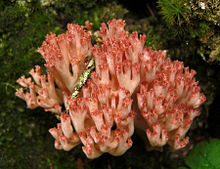
Back راماريا بوتريتيس Arabic راماريا بوتريتيس ARZ Ramaria botrytis AST Червеновърха коралка Bulgarian Coliflor (bolet) Catalan Ramaria botrytis CEB Kuřátka květáková Czech Cwrel rosso Welsh Hahnenkamm-Koralle German Ramaria botrytis Spanish
| Ramaria botrytis | |
|---|---|

| |
| Scientific classification | |
| Domain: | Eukaryota |
| Kingdom: | Fungi |
| Division: | Basidiomycota |
| Class: | Agaricomycetes |
| Order: | Gomphales |
| Family: | Gomphaceae |
| Genus: | Ramaria |
| Species: | R. botrytis
|
| Binomial name | |
| Ramaria botrytis | |
| Synonyms[1] | |
| Ramaria botrytis | |
|---|---|
| Smooth hymenium | |
| No distinct cap | |
| Stipe is bare | |
| Spore print is yellow | |
| Ecology is mycorrhizal | |
| Edibility is edible but not recommended | |
Ramaria botrytis, commonly known as the clustered coral, the pink-tipped coral mushroom, or the cauliflower coral, is an edible species of coral fungus in the family Gomphaceae. Its robust fruit body can grow up to 15 cm (6 in) in diameter and 20 cm (8 in) tall, and resembles some marine coral. Its dense branches, which originate from a stout, massive base, are swollen at the tips and divided into several small branchlets. The branches are initially whitish but age to buff or tan, with tips that are pink to reddish. The flesh is thick and white. The spores, yellowish in deposit, are ellipsoid, feature longitudinal striations, and measure about 13.8 by 4.7 micrometers.
The type species of the genus Ramaria, R. botrytis was first described scientifically in 1797 by mycologist Christiaan Hendrik Persoon. A widely distributed species, it is found in North America, North Africa, central and eastern Europe, Australia, and Asia. The fungus is mycorrhizal with broadleaf trees, and fruits on the ground in wooded areas. There are several species of coral fungi that are superficially similar in appearance to R. botrytis, and although comparison of habitat or characteristics like color or branching morphology is often sufficient for identification, sometimes microscopy is required to definitively distinguish between them. Fruit bodies of Ramaria botrytis are edible, and young specimens have a mild, fruity taste. Some authors warn of laxative effects in susceptible individuals. The fungus contains several chemical compounds with in vitro biological activity, and fruit bodies have antimicrobial activity against several species and strains of drug-resistant bacteria that cause disease in humans.
© MMXXIII Rich X Search. We shall prevail. All rights reserved. Rich X Search